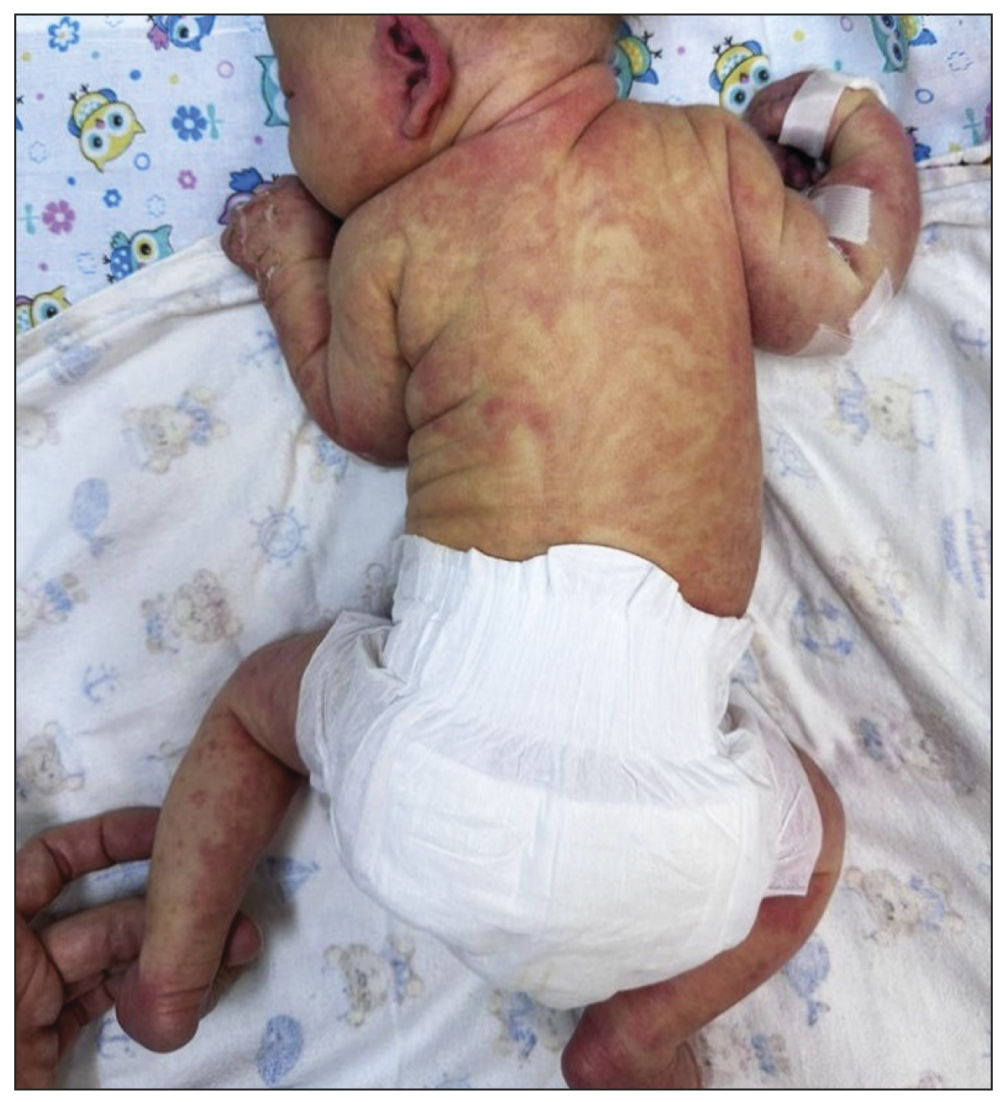Magnetic resonance imaging for diagnosing a rare disease: incontinentia pigmenti (Bloch–Sulzberger syndrome) on the example of a clinical case
- Авторлар: Yarmola I.I.1, Anikin A.V.1, Gankin D.A.2, Fomina L.E.1, Kharitonova N.A.1, Zhanin I.S.1, Pushkov A.A.1, Basargina M.A.1, Kondakova O.B.1
-
Мекемелер:
- National Medical Research Center for Children's Health
- Shchelkovsky Perinatal Center
- Шығарылым: Том 4, № 3 (2023)
- Беттер: 384-392
- Бөлім: Case reports
- URL: https://bakhtiniada.ru/DD/article/view/254076
- DOI: https://doi.org/10.17816/DD430154
- ID: 254076
Дәйексөз келтіру
Аннотация
Incontinentia pigmenti, also known as Bloch–Sulzberger syndrome, is a rare hereditary disease characterized by typical skin rashes and involvement of other organs and systems. Magnetic resonance imaging stands as the primary method for visualizing the structural pathology of the brain and predicting neurological manifestations in an affected child.
Diagnosing incontinentia pigmenti predominantly falls within the domain of dermatologists; verification is performed by molecular genetic analysis of the IKBKG gene. This study involved magnetic resonance imaging of the brain in a patient with skin rashes, characteristic of Bloch–Sulzberger syndrome, and deletion in the IKBKG gene, where numerous foci of ischemia, hemorrhages, and lesions of the tracts were detected.
Magnetic resonance imaging of the brain in patients with Bloch–Sulzberger syndrome is used to evaluate the severity of damage to the brain substance, which makes it possible to explain the cause of neurological symptoms and correct habilitation, as well as predict the development of the child.
Толық мәтін
##article.viewOnOriginalSite##Авторлар туралы
Igor Yarmola
National Medical Research Center for Children's Health
Хат алмасуға жауапты Автор.
Email: lord_dukich@bk.ru
ORCID iD: 0000-0002-1272-5119
SPIN-код: 5591-8066
Ресей, Moscow
Anatoly Anikin
National Medical Research Center for Children's Health
Email: anikacor@gmail.com
ORCID iD: 0000-0003-0362-6511
SPIN-код: 7592-1352
MD, Cand. Sci. (Med.)
Ресей, MoscowDmitry Gankin
Shchelkovsky Perinatal Center
Email: ganja-nn@yandex.ru
ORCID iD: 0009-0001-6779-8702
Ресей, Schelkovo
Lyubov Fomina
National Medical Research Center for Children's Health
Email: love.fomina@mail.ru
ORCID iD: 0000-0002-3838-3284
SPIN-код: 1298-8350
Ресей, Moscow
Natalia Kharitonova
National Medical Research Center for Children's Health
Email: kharitonovan@nczd.ru
ORCID iD: 0000-0002-6912-1471
SPIN-код: 7379-8269
MD, Cand. Sci. (Med.)
Ресей, MoscowIlya Zhanin
National Medical Research Center for Children's Health
Email: zhaninis@nczd.ru
ORCID iD: 0000-0003-1423-0379
SPIN-код: 6108-2016
MD, Cand. Sci. (Med.)
Ресей, MoscowAleksandr Pushkov
National Medical Research Center for Children's Health
Email: n1972z@yandex.ru
ORCID iD: 0000-0001-6648-2063
SPIN-код: 2928-5764
Cand. Sci. (Biol.)
Ресей, MoscowMilana Basargina
National Medical Research Center for Children's Health
Email: kharitonovan@nczd.ru
ORCID iD: 0000-0003-2075-6668
SPIN-код: 5504-7154
MD, Cand. Sci. (Med.)
Ресей, MoscowOlga Kondakova
National Medical Research Center for Children's Health
Email: n1972z@yandex.ru
ORCID iD: 0000-0002-6316-9992
SPIN-код: 9066-3698
MD, Cand. Sci. (Med.)
Ресей, MoscowӘдебиет тізімі
- Scheuerle AE, Ursini MV, Adam MP, et al. Incontinentia Pigmenti. In: GeneReviews [Internet], Seattle (WA): University of Washington, Seattle; 1993.
- Fusco F. Molecular analysis of the genetic defect in a large cohort of IP patients and identification of novel NEMO mutations interfering with NF-B activation. Hum Mol Genet. 2004;13(16):1763–1773. doi: 10.1093/hmg/ddh192
- Yadlapati S, Tripathy K. Incontinentia pigmenti (Bloch Sulzberger Syndrome). In: StatPearls [Internet]. Treasure Island (FL): StatPearls Publishing; 2023.
- Savostyanov KV. Modern algorithms of genetic diagnosis of rare hereditary diseases in Russian patients. Moscow: Polygraphist Publisher; 2022. 451 р. (In Russ).
- Minić S, Cerovac N, Novaković I, et al. The impact of the IKBKG gene on the appearance of the corpus callosum abnormalities in incontinentia pigmenti. Diagnostics. 2023;13(7):1300. doi: 10.3390/diagnostics13071300
- Chistiakov DA, Savostanov KV, Kuzenkova LM, et al. Molecular characteristics of patients with glycosaminoglycan storage disorders in Russia. Clin Chim Acta. 2014;(436):112–120. doi: 10.1016/j.cca.2014.05.010
- Chistyakov DA, Savostanov KV, Nosikov VV, Turakulov RI. Genetic determinants of Graves’ disease. Mol Gen Metabol. 2000;71(1-2):66–69. doi: 10.1006/mgme.2000.3042
- Meuwissen ME, Mancini GM. Neurological findings in incontinentia pigmenti: A review. Eur J Med Genet. 2012;55(5):323–331. doi: 10.1016/j.ejmg.2012.04.007
- Carney RG. Incontinentia pigmenti. A world statistical analysis. Arch Dermatol. 1976;112(4):535–542.
- Minić S, Trpinac D, Obradović M. Incontinentia pigmenti diagnostic criteria update. Clin Genet. 2014;85(6):536–542. doi: 10.1111/cge.12223
- Haque MN, Ohtsubo M, Nishina S, et al. Analysis of IKBKG/NEMO gene in five Japanese cases of incontinentia pigmenti with retinopathy: Fine genomic assay of a rare male case with mosaicism. J Hum Genet. 2021;66(2):645–645. doi: 10.1038/s10038-020-00836-3
- Kawai M, Kato T, Tsutsumi M, et al. Molecular analysis of low-level mosaicism of the IKBKG mutation using the X Chromosome Inactivation pattern in Incontinentia Pigmenti. Mol Genet Genomic Med. 2020;8(12):e1531. doi: 10.1002/mgg3.1531
- Tak PP, Firestein GS. NF-κB: A key role in inflammatory diseases. J Clin Invest. 2001;107(1):7–11. doi: 10.1172/JCI11830
- Kleinman JT. Early Wallerian degeneration on magnetic resonance imaging: Underappreciated but highly relevant. Dev Med Child Neurol. 2013;55(2):104–105. doi: 10.1111/dmcn.12022
- Salamon SA, Lichtenbelt K, Cowan FM, et al. Clinical presentation and spectrum of neuroimaging findings in newborn infants with incontinentia pigmenti. Dev Med Child Neurol. 2016;58(10):1076–1084. doi: 10.1111/dmcn.13140
- Lou H, Zhang L, Xiao W, et al. Nearly completely reversible brain abnormalities in a patient with incontinentia pigmenti. Am J Neuroradiol. 2008;29(3):431–433. doi: 10.3174/ajnr.A0890
- Kinoshita T, Ogawa T, Yoshida Y, et al, Curvilinear T1 hyperintense lesions representing cortical necrosis after cerebral infarction. Neuroradiology. 2005;47(7):647–651. doi: 10.1007/s00234-005-1398-0
- Hauw JJ, Perié G, Bonnette J, Escourolle R. [Neuropathological study of incontinentia pigmenti. Anatomical case report (author’s transl). (In French)]. Acta Neuropathol. 1977;38(2):159–162. doi: 10.1007/BF00688564
Қосымша файлдар












